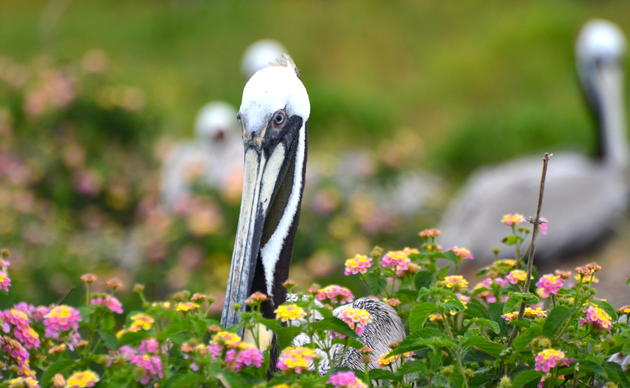Great Blue Heron
The Great Blue Heron is the largest of the North American herons, standing 45-54 inches tall with a wingspan of 66-79 inches. They are seen throughout North America, hunting in shallow water or open fields. When hunting, Great Blue Herons can be seen standing statue-like or wading slowly as they stalk fish and other small prey.
According to records from the Texas Colonial Waterbird Society surveys from 1973-1990 the majority of the Texas Great Blue Heron population is coastal (between 49 to 91% each year). In Texas, the largest colonies are in the forested east inland region and on coastal islands where they nest with other colonial waterbirds. Nest site habitat in Texas is variable; Great Blue Herons will use trees, shrubs, channel markers, artificial nest platforms and will nest on the ground on predator-free islands (when sites with trees are not available).
Ideal foraging habitat is within 2.3 to 6.5 km from the nest site and includes shallow coastal marine waters, coastal mangrove swamps, sea beaches, prairie, pasture and cultivated fields, and aquaculture fields. Predator presence also affects colony site selection, when mammalian predators are common, herons will select sites more difficult to reach in high trees or on islands.
For more information, and tips on how to identify Great Blue Herons, visit their page on the Cornell Lab of Ornithology.
Text References
- Telfair, R. 2001. Great Blue Heron. The Texas Breeding Bird Atlas.
- Vennesland, R. G. and R. W. Butler. 2011. Great Blue Heron (Ardea herodias).in A. Poole, editor. The Birds of North America Online. Cornell Lab of Ornithology, Ithaca.
How you can help, right now
Join Audubon Texas Today
Becoming a member supports our local work protecting birds and the places they need.
Consider a Legacy Gift for Texas
Planned gifts and bequests allow you to provide a lasting form of support to Audubon Texas.
Subscribe to Our Newsletter
Subscribe to our newsletter for updates about Audubon Texas's conservation work, and news about our activities and local events.




